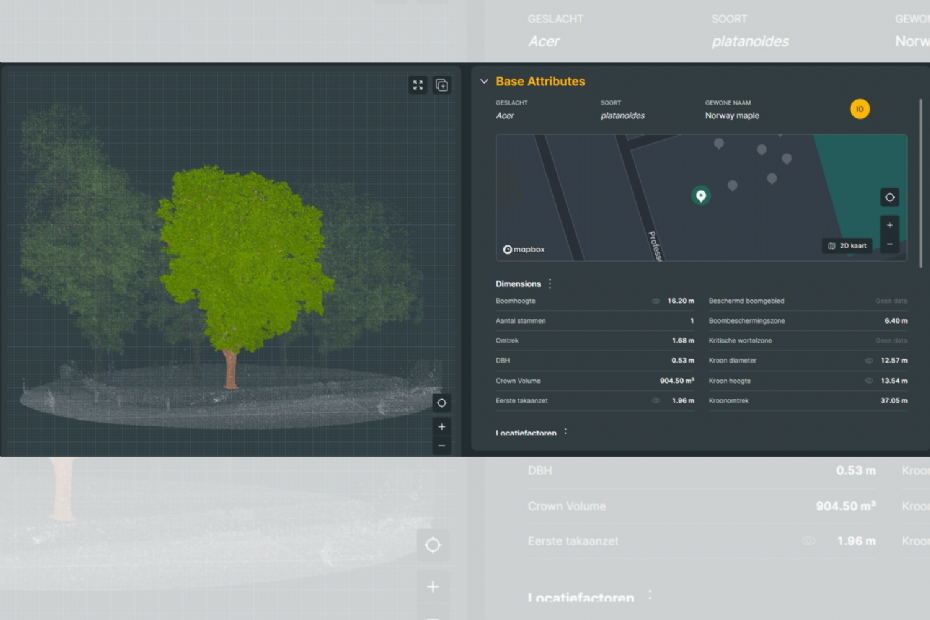'Laser scanning, machine learning, and AI lay the foundation for our future-proof tree policy' |
|
| GARDEN AND PARK TECHNOLOGY |
|
|
|
|
 |
| 179 sec |
Municipality of Land van Cuijk innovates tree policy thanks to the merger of five municipalities
Three years ago, the municipality of Land van Cuijk was established in its current form. Formed from five municipalities, it now has the capacity to implement an innovative policy. 'We have developed our new tree policy and are participating in projects such as the Greehill technology initiative, which involves multiple municipalities, and CSI Trees for climate-adaptive trees. As separate municipalities, we wouldn't have been able to do that,' says Peter Scheepers.
| From left to right: Ruud Custers, Peter Scheepers, and Jeroen Burgman |
The three representatives from the municipality of Land van Cuijk attending the interview are enthusiastic—about the Dutch Tree Information Day, where they are the host municipality, about the innovative tree policy they will present as keynote speakers alongside Cecil Konijnendijk, and about their participation in the laser scanning project with Greehill in collaboration with Terra Nostra. And that's not all. The municipality is also involved in CSI Trees, a project for climate-resilient trees, which will be discussed in a workshop at the Dutch Tree Information Day. Additionally, they are collaborating with students from HAS Green Academy to explore new perspectives on public green spaces.
We speak with Peter Scheepers, Senior Advisor for Green and Nature, Tree Consultant Ruud Custers, and Tree Manager Jeroen Burgman about their contribution to the Dutch Tree Information Day and their ongoing projects related to trees in the largest municipality of North Brabant.
Merged municipality
The municipality of Land van Cuijk was formed three years ago from the merger of five municipalities: Cuijk, Boxmeer, Grave, Mill and Sint Hubert, and Sint Anthonis. In terms of land area, it is the largest municipality in North Brabant. It manages approximately 90,000 trees, with one-third located in urban areas and two-thirds in rural areas.
|
Living street
Three HAS students recently completed an inspiring document to encourage the municipality to rethink public space design. Peter Scheepers shows the brochure: 'This was created as part of the Climate-Resilient Land van Cuijk implementation program. It presents a typical street with facades on both sides, parking spaces in front of houses, and limited space left for greenery and a single tree. The students proposed an alternative approach: designing the street as a "living street" with parking at one end, allowing space in the middle for a green strip with trees, edible plants, and a pedestrian and bicycle path. And not to forget: sufficient water retention capacity.'
Digital twin
Scheepers values this project and already has plans for the next group of students. For now, he highlights another project: 'We are one of the municipalities participating in the Greehill technology project, now in its second year of a three-year initiative. This means that all our municipal trees are being mapped using laser scanning technology from a scan vehicle. Machine learning and AI generate a wealth of information and insights, aiding in the management of our 90,000 municipal trees. This provides data on green structures but also detailed information about individual trees. It is especially valuable given the shortage of tree inspectors.' Thanks to the enthusiasm of his colleague Burgman, the project is running smoothly. Scheepers adds, 'Our ambition is to be the first municipality in the Netherlands to have a complete digital twin of our tree inventory.'
 | | Digital twin of an Acer platanoides in the municipality |
|
|
|
|
'Our ambition is to be the first municipality in the Netherlands to have a complete digital twin of our tree inventory.'
| |
|
'I have to be careful not to get carried away with all the possibilities this project offers,' Burgman admits. 'One example is that we now have a much stronger position in public space projects. Instead of just saying that trees have "a lot" of water retention capacity, we can now provide exact figures. This makes us an equal discussion partner alongside the colleagues designing the sewer systems.'
Machine learning and AI
'Even while still in the pilot phase, this project is already proving valuable,' Custers says. 'We are currently refining the technology, essentially contributing to its programming. For instance, the scanner may identify a tree as one type of linden when we know it is actually another. We help the system learn to distinguish between them. A fun example is that we recently discovered two olive trees in the municipality—only to realize they were potted trees on a terrace, not part of public space. These kinds of findings help refine the system, making it increasingly intelligent and reliable through machine learning, AI, and our input.'
|
|
'The system is becoming increasingly intelligent and reliable through machine learning, AI, and our input.'
| |
|
Burgman finds the rapid development somewhat overwhelming: 'Things are moving very fast. The system is getting smarter, and tree inventorying is becoming faster with fewer people. For example, inspectors no longer need to manually measure clearance heights; the scanner captures this automatically. A practical application is that we can instantly see which areas require pruning to maintain clearance heights.'
'Another fun example is that we can now precisely determine the possible routes for the carnival parade if we know the dimensions of the tallest and widest floats,' Scheepers adds with a grin. 'And I'm serious—carnival is probably the biggest event we have in Land van Cuijk.'
3-30-300
Burgman concludes: 'This project also helps us create better growing conditions for trees. And that ties into what we'll be discussing at the Dutch Tree Information Day: applying and concretely implementing the 3-30-300 rule in Land van Cuijk.'
This article was originally published on February 12, 2025, on the Boomzorg website.
| LOG IN
with your email address to respond.
|
|
|
| There are no comments yet. |
Tip the editors
|